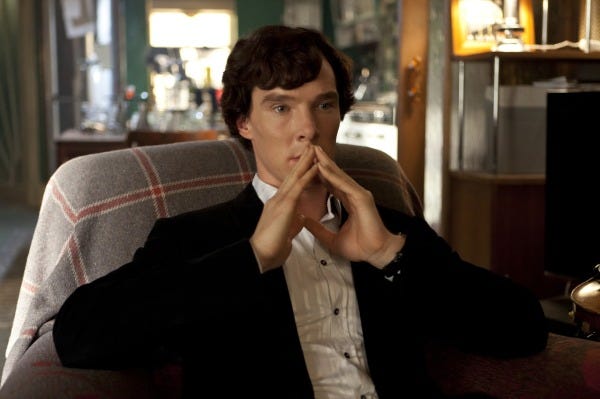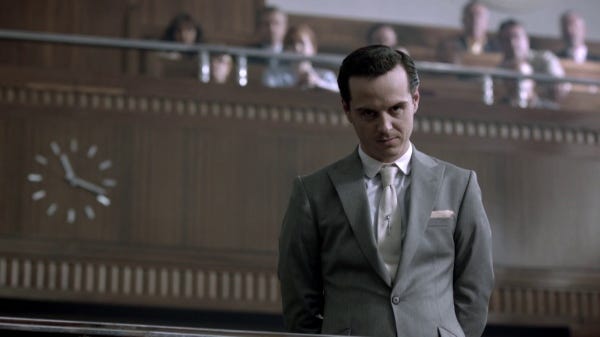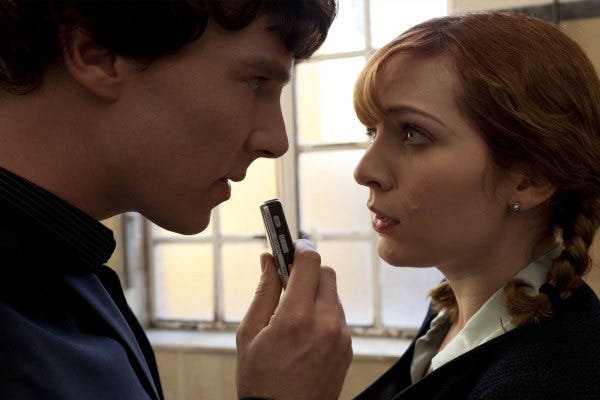NOTE: Since we already had RR#5 up here during Hound week, I’m not going to re-re-post that, but have instead skipped to #6. This original retro review appeared on the Sherlock’s Home website in 2016, and has been slightly adapted since. As usual, this was originally on a UK-based site, and so my spelling and punctuation reflects that. Usually. When I remember. :) And go here if you’re interested in reading #5 in its proper order.
Written by Prof. Jenn
As a reminder: I am writing these as RETROSPECTIVE reviews, so I will be discussing reveals, resolutions of cliffhangers, ends of plots, etc. If you are reading these reviews without having seen the eps, a) what is wrong with you?? Go watch them now! and b) these reviews are not for you till you’ve seen them.
Conspiracies abound in ‘The Reichenbach Fall’, culminating in one of the heftier cliffhangers of the series as a whole. Though for those of us who are familiar with the original Doyle, perhaps the surprise at the very end isn’t so very surprising, nor is the reveal in Series 3. In fact, I have a major beef about the conclusion of the elaborate trap Moriarty sets for Sherlock in this episode… but I’m getting ahead of myself.
This episode begins with a confession of grief on the part of John Watson, who tells his therapist that Sherlock Holmes is dead. This no doubt is meant to give us all a whaaaa?? moment before we plunge headlong into the events that lead up to said apparent demise.
Sherlock’s career success is shown to us in montage form, with several nods to original canon (the Reichenbach Falls, after all, is where Moriarty and Holmes apparently die in Doyle’s ‘The Final Problem’) and then we get another montage-y view of the criminal shenanigans Moriarty is getting up to, along with a beautiful Nina Simone soundtrack.
Turns out our good friend ‘Jim from IT’ has been up to all sorts of no good since being released from that torture chamber by Mycroft we saw in the previous episode, and has apparently some sort of cybernetic master key that can open any door to him whatsoever. Kidnapped children and a thrown trial are only two of the crazily insurmountable obstacles Sherlock must surmount in order to nab Moriarty once and for all, and it doesn’t prove easy, even for him. In fact, the solution has to involve his own apparent suicide.
The overelaborate trap Moriarty sets for Sherlock is ingenious in that it involves the tarnishing of Sherlock’s reputation (helped by pivotal character, reporter Kitty Riley), and also sets his death in motion with no possibility of reversal (even when Moriarty offs his own self). Problem is, much of this trap setting is a) incomprehensible, and b) doesn’t get resolved, even when it ostensibly is all resolved by the beginning of ‘The Empty Hearse.’
I’ll go into more detail about the cliffhanger’s disappointing ‘conclusion’ in that episode’s retro-review, but suffice to say that by the end of this ep, the police (even Lestrade has doubts), the public, and to some extent Mycroft are all against Sherlock Holmes, and his death is not only a way to save his friends but to erase his public image in such an indelible way as to be able to start afresh. Or so we’re led to believe. At any rate, the conspiracy is a little spooky, what with the poisoned children and the assassins getting popped off if they so much as touch Sherlock, but it all feels very sloppy, and like there are too many loose ends. Methinks this is a Steven Moffat writing flaw, as I have felt the same way about some of his more elaborate many-episode-long through-lines in Doctor Who.
FINAL THOUGHT: The two most pivotal scenes in this ep are: the confrontation in 221B Baker Street between Sherlock and Moriarty, and the final double suicide scene. The former is reminiscent of the original canon, but also Rathbone Holmes movie The Woman in Green, the staircase ascension of which Mofftiss admit to stealing, as it’s such a compelling bit of cinematography. The former is interesting as a Sherlockian, too, because (as Moffat has said in more than one interview) in the original, Doyle kills Holmes offstage. We don’t see his death, we only have a note left behind for Watson and the police. In this ep, the screenwriter is bold as brass, in that not only is this *not* a struggle to a topple (as in the original) but an apparent suicide, but ALSO we see it happen!
With John, we watch Sherlock jump off the roof, and fall. We see the impact (or we think we do—do we, though?), we see his bleeding corpse hauled off by hospital professionals, we see his gravestone. Of course, we then get the reveal at the end that Sherlock is alive*, and have till Series 3 to wait to see how he made it.
*Why did they choose to do that, anyone know? Was it just to make sure all their viewers would return for the next series? Was it to engender the flurry of speculation which did occur, of how Sherlock survived? Was it for fans who never read the original?
EASTER EGG: The painting ‘The Reichenbach Fall’ which we see in the beginning as one of many difficult solved cases Sherlock is celebrated for, looks almost exactly like Paget’s illustration of the fateful scene in ‘The Final Problem.’ A similar image can be found on the wall of 221B as a decoration in the Granada series, too.
FINAL FINAL THOUGHT: Martin Freeman’s performance of the graveside monologue at the end of this episode is some of the best acting you’ll see on big or small screens, ever. That is all.
RATING: 3 mysterious snipers out of 5.






